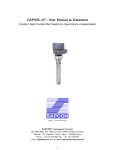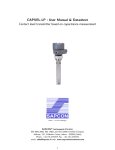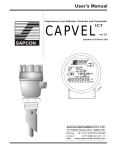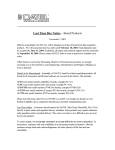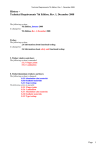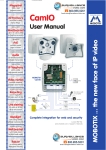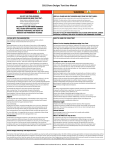Download RF Admittance Type Level Limit Switch User Manual
Transcript
RF Admittance Type Level Limit Switch User Manual & Data Sheet RF Admittance Level Limit Switch Table of contents 1. Introduction……………………………………………………………………………………………………01 2. Operating Principle………………………………………………………………………………………….02 3. Features………………………………………………………………………………………………………….03 4. Application Note……………………………………………………………………………………………...04 5. Technical Data………………………………………………………………………………………………...05 6. Installation Guidelines……………………………………………………………………………………..06 7. Calibration………………………………………………………………………………………………………07 8. Precautions……………………………………………………………………………………………………..08 9. Maintenance……………………………………………………………………………………………………09 10. Trouble Shooting…………………………………………………………………………………………….10 11. Recommended Spares……………………………………………………………………………………..11 12. Warranty………………………………………………………………………………………………………..12 13. Customer Service…………………………………………………………………………………………….13 Introduction: Sapcon admittance level limit switch utilizing specially designed Immunocoat probe offers a reliable solution to level detection problems so far difficult to solve with capacitance type system utilizing conventional probes. The main advantage offered by admittance range of level switches is their ability to ignore build up and coating of material on the probe. Purpose of adding a shield in between sensing element and ground is to avoid RF currents from reaching the container wall via the coating. Although there would be RFcurrent flowing between the shield and the container wall via the build up, it would not be considered by the measuring circuit and will not affect on the level measurement. This unique design enables the electronic circuitry to distinguish between significant process coating and the actual process material thereby gives reliable accurate switching. . Operating Principle: The sensing element and the container wall (or ground electrode) form a means to measure the admittance of the system with & without the intervening material. When all the parameters that affect the admittance value are kept constant then its value changes only due to the difference in material level. The sensed signal is further amplified and used to actuate the relay. The relay contacts are used for alarm or control purpose. System Description & Features: A complete measuring system comprises: I. Evaluation unit II. Immuno coat probe III. Interconnecting cable Immunocoat probe is of a special construction with three concentrically positioned electrodes that are electrically insulated from each other. The innermost electrodes serve as the sense electrode whereas the one next to it is the shield, and the outermost is ground. The sense electrode is connected to a radio frequency source and the shield is also connected to the same source but through an isolating amplifier. They therefore have identical waveforms and the shield follows the sense, maintaining equivalent potential, frequency and phase relationship. Due to this there is no flow of RF current between the shield and the sense electrode. The flow of RF currents via the shield to sidewalls does not affect the measurement due to isolation amplifier . The probe head is of cast aluminum weatherproof construction provided with suitable cable glands, and fitted on to the probe mounting arrangement. A discharge device is provided with the system where there is a possibility of generation of static charge in the service material. The immuno coat probe is connected to the evaluation unit with a special screened cable of pre- trimmed length. The Evaluation unit is housed in a cast aluminum weatherproof housing that is stoving enamel painted & provided with three nos. of cable entries of ½" size. The electronics and the inter-connecting terminals are assembled on a glass epoxy printed circuit board that is heavily lacquered for rendering it immune to moisture, dust & fungus. Application Note: Admittance measurement using Immunocoat probe gives satisfactory solution in tough environments where, 1. Material has a tendency to coat. 2. There is bridging (build up) of material between probe and sidewall. 3. Material particles with electrostatic charge and varying temperature float in the vicinity of the probe. Technical Data: Installation Guidelines: Instrument can be installed in almost any position. Install probe in such a way that sense, shield & non active length must come in active zone. The threaded mounting connection should be as short as possible to avoid deposit of material in the nozzle cavity. When mounting is from side, the cable entry should be pointing downwards, so that no moisture can enter. Make sure that the probe insulation is not damaged when inserting through the nozzle. Probe should be installed away from the inlet. If it is not possible, fix baffle plate 300 mm above from the probe. Always refer the attached diagram before making the interconnection. One such diagram is also pasted inside the evaluation cover. Connect the mains supply as mentioned inside the cover. Verify the line voltage before switching ON the instrument. Interconnection b/w probe and evaluation unit is made by special PTFE coaxial cable of pretrimmed length. Ensure control unit is earthed properly. Use three core cables of 1.5 sq mm diameters, in case of AC power supply & relay contacts. Connection diagram: Installation Figure: SIDE MOUNTED PROBE Calibration: (For DOT Display Model SLA…M Series) A DOT DISPLAY model serves as a sensitivity indicator. The indicator range is divided in to TEN parts. The divisions are as follows: Sensitivity Regions The Following standard procedure should be carried out when tank is empty. Switch ON the mains voltage. Select the desired fail safe by using FSS toggle switch. For versions provided with adjustable time delay, turn the POT fully counter clockwise to the minimum delay condition. Now rotate the sensitivity adjustment POT fully counter clockwise. In this condition the DOT display will be GREEN. Fill the level up to the probe, so that it covers the probe tip sufficiently. Rotate the sensitivity POT gradually clockwise observing the DOT display move through the green and yellow region to the RED region. Continue the turning of potentiometer until the relay just operates. This should occur close to the RED region. Without disturbing the sensitivity POT reduce the level of material. As the probe gets uncovered the DOT display will move from RED through Yellow to Green. Record this display indication for future reference. The calibration is now completed. (For BAR Display SLA…B series) The following standard procedure should be carried out when tank is empty. Switch ON the mains power supply. Select the desired fail-safe by using FSS toggle switch. For version provided with adjustable time delay, turn the POT fully counter clockwise to the minimum delay condition. Ensure all the four DIP switches just below SENS trimmer are in OFF position. Note the display in SENS/DEV indicator. If all the RED LEDs are glowing along with the alarm RED LED, the turn the SENS trimmer slowly towards anticlockwise. If alarm condition does not change, then PUT DIP switches 1 to ON condition. If the RED LED alarm still glows than put DIP switch 1 to OFF condition & turn the DIP switch2,3 or 4 to ON condition till green LED glows & note if SENS/DIV indicator shows any LED glowing. Rotate the SENS trimmer slowly towards clockwise direction till display is ON. SESN/DIV indicator shows 4 LED’s glowing. Fill the level up to probe, so that it covers the probe tip sufficiently. If the RED alarm LED glows along with the relay changeover, than the calibration is complete. If the green LED still glows that further rotate the SENS trimmer clockwise till the RED alarm LED glows. NOTE: For probe uncovered and display set to 6th LED, the Green indicator LED glows when FSS is set to High mode whereas Red indicator LED glows when FSS is set to Low mode. Fail Safe Mode: This is field selectable option depending upon the process requirement. Maximum fail safe or minimum fail-safe can be obtained by selecting the FSS toggle switch mounted in the centre of the PCB. De-energized condition of the relay is used to initiate an alarm. Even if the mains supply fails or instrument doesn’t work, relay will initiate an alarm. Maximum Fail Safe - When the level rises and the material covers the probe the relay is de-energized, an alarm is initiated and Red LED glows. For achieving this mode of operation shift the toggle switch to fail safe high. Minimum Fail safe - When the level falls and the probe is un-covered, the relay is deenergized, an alarm is initiated and Red LED glows. For achieving this mode of operation shift the toggle switch to failsafe low. Precautions: Refer the diagram pasted inside the cover before making the interconnection. Do not immediately energize the instrument until wires are fully secured. In case of DC power supply instrument –ve is ground. Always tighten the housing cover and the cable entry securely. Use appropriate size of spanner for rotating mounting bush. True earths must be connected to the instrument. Use recommended cable only for interconnection. Weatherproofness of enclosure is guaranteed only, if the cover is in place & cable glands are adequately tightened. Safety Information & Maintenance: Before installing the admittance level controller, please read these instruction’s carefully and familiarize yourself fully with the requirement and functions of the instrument. Please do not dispose off the carton or packing material until the unit has been inspected in all respects. If the unit is received in damaged condition, kindly note the dispatch details and inform us immediately Interconnection must be done as per the national standards. If you find any difficulty or have any doubts about installing this product, please do not hesitate to contact our service center for instant support. Trouble Shooting: Wire connections: DOT DISPLAY CONNECTIONS GA Drawing: RF Admittance GA Drawing Recommended Spares: * Instrument having no moving part therefore no wear and tear. However we advice to keep at least one set of card and probe assembly, if population of instrument are more. Warranty: Instrument is manufactured as per the purchase order specification. Standard guarantee for twelve months from the date of commissioning or eighteen months from the date of supply. Which ever is earlier. Guarantee is against manufacturing defects. We undertake to correct such defects which are due to workmanship, at our expenses, Instrument should be forwarded to us on freight paid basis with seals unbroken. The guarantee is valid for our customer and does not extent to third parties or caused by mishandling, accident or abnormal conditions. Customer Service: If you require any assistance or clarification please free to contact with following details at the address given below. A. Instrument Model & serial no. B. Purchase order no. & date C. Problem observed Sapcon Instruments (P) Ltd 131, Palshikar colony Indore 452004 India Ph no.0731-2475751-52-53, 4082751 Fax 0731- 2475475 Email [email protected], [email protected] Website www.sapconinstruments.com












